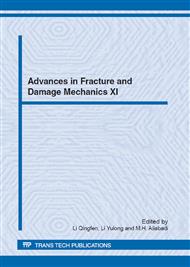p.589
p.593
p.597
p.601
p.605
p.609
p.613
p.617
p.621
Investigation of Damping Characteristics of Metals by the Use of Inverted Torsion Pendulum Method
Abstract:
Damping characteristics of metals are measured by the use of inversed torsion pendulum method. As the materials, aluminum alloys, magnesium alloys, Inconel etc are used with the temperature and frequency parameters. Mild steel is employed as a reference material for calibrating the apparatus. The measured damping coefficient of magnesium alloys is larger than that of aluminum alloys indicating that the HCP crystal structure has more damping effect than the FCC structure. The damping of these metals increases with temperature. The manner of increment of damping is investigated to analyses the microscopic mechanism of damping.
Info:
Periodical:
Pages:
605-608
Citation:
Online since:
November 2012
Price:
Сopyright:
© 2013 Trans Tech Publications Ltd. All Rights Reserved
Share:
Citation:


